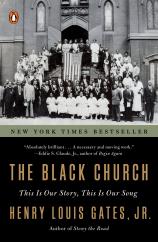The Black Church: This Is Our Story, This Is Our Song
Review
The Black Church: This Is Our Story, This Is Our Song
THE BLACK CHURCH is bestselling author and noted scholar Henry Louis Gates, Jr.’s written accompaniment to his PBS series of the same name. Here, he offers a wide panorama of history and hope underpinning the gradual development of religion in its myriad forms among Black Americans.
The majority of slaves brought to the new colonies were not expected to adopt the religion of the colonists. In fact, doing so would have placed their owners in an untenable position, since slavery is against Christian tenets. To justify keeping them out of white religion and in chains, it was stressed that Africans were inherently inferior. So no teaching was done, which explains why, once Black houses of worship sprang up, they also served as schools.
"Gates fairly and objectively shows how Black churches have incorporated both African traditions and highly advanced, almost visionary concepts of tolerance and freedom in the face of overt and subtle racism."
Some slaves were converts to Catholicism, largely in Spanish-dominated Florida. And some, mainly in coastal South Carolina, brought Islamic beliefs that would later resurface in such guises as the Nation of Islam, which countered the notion of white supremacy with the idea of white people as inferior, as the enemy. Most slaves carried within them their African traditions, in which worship was a shared experience, featuring such phenomena as response singing, dancing and circle shouts that became an integral part of African American worship.
Gates fairly and objectively shows how Black churches have incorporated both African traditions and highly advanced, almost visionary concepts of tolerance and freedom in the face of overt and subtle racism. His story of Mother Emanuel AME Church in Charleston, South Carolina, illustrates the daunting path that Black people have had to tread in their thirst for the salvation that they so clearly perceived in the person of Jesus. Built in 1817 as the first official Black denominational institution, it was burned by whites a few years later, rebuilt by Blacks after the Civil War, and in 2015 became the scene of a massacre of nine innocent parishioners by a rabid young white supremacist.
Gates asserts that Black churches have generally required their members to hold fast to faith through conversion, followed by lifelong commitment, citing his youthful experiences as an example. Bringing the history up to the present, he notes that women have gained more power in the Black church hierarchy, issues such as LGBTQ+ rights have yet to be resolved, and Obama’s presidency moved the churches a step forward. This past year of COVID-19 undeniably has had some negative effects: the proportions of Black people with the virus, the inability to perform community outreach or meet together in what often can be highly interactive Sunday services, and the upsurge in white violence against African Americans.
Still, hopes run high for a continuation and expansion of what Gates thinks of as “the space where our direct cultural ties to Africa come to life in new and mutated but still recognizable form…the place where we made a way out of no way.”
Reviewed by Barbara Bamberger Scott on February 19, 2021
The Black Church: This Is Our Story, This Is Our Song
- Publication Date: January 18, 2022
- Genres: History, Nonfiction, Politics, Religion
- Paperback: 304 pages
- Publisher: Penguin Books
- ISBN-10: 1984880357
- ISBN-13: 9781984880352




